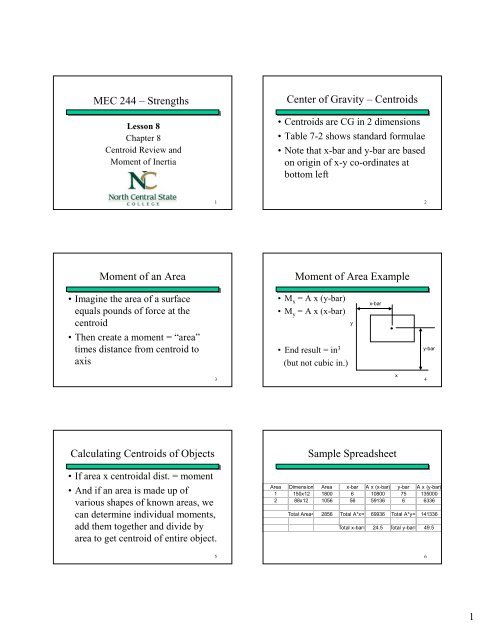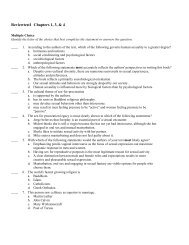Centroid and Moment of Inertia Notes
Centroid and Moment of Inertia Notes
Centroid and Moment of Inertia Notes
You also want an ePaper? Increase the reach of your titles
YUMPU automatically turns print PDFs into web optimized ePapers that Google loves.
MEC 244 – Strengths<br />
Lesson 8<br />
Chapter 8<br />
<strong>Centroid</strong> Review <strong>and</strong><br />
<strong>Moment</strong> <strong>of</strong> <strong>Inertia</strong><br />
Center <strong>of</strong> Gravity – <strong>Centroid</strong>s<br />
• <strong>Centroid</strong>s are CG in 2 dimensions<br />
• Table 7-2 shows st<strong>and</strong>ard formulae<br />
• Note that x-bar <strong>and</strong> y-bar are based<br />
on origin <strong>of</strong> x-y co-ordinates at<br />
bottom left<br />
1<br />
2<br />
<strong>Moment</strong> <strong>of</strong> an Area<br />
<strong>Moment</strong> <strong>of</strong> Area Example<br />
• Imagine the area <strong>of</strong> a surface<br />
equals pounds <strong>of</strong> force at the<br />
centroid<br />
• Then create a moment = “area”<br />
times distance from centroid to<br />
axis<br />
• M x = A x (y-bar)<br />
• M y = A x (x-bar)<br />
• End result = in 3<br />
(but not cubic in.)<br />
y<br />
x-bar<br />
y-bar<br />
3<br />
x<br />
4<br />
Calculating <strong>Centroid</strong>s <strong>of</strong> Objects<br />
• If area x centroidal dist. = moment<br />
• And if an area is made up <strong>of</strong><br />
various shapes <strong>of</strong> known areas, we<br />
can determine individual moments,<br />
add them together <strong>and</strong> divide by<br />
area to get centroid <strong>of</strong> entire object.<br />
Sample Spreadsheet<br />
Area Dimension Area x-bar A x (x-bar) y-bar A x (y-bar)<br />
1 150x12 1800 6 10800 75 135000<br />
2 88x12 1056 56 59136 6 6336<br />
Total Area= 2856 Total A*x= 69936 Total A*y= 141336<br />
Total x-bar= 24.5 Total y-bar= 49.5<br />
5<br />
6<br />
1
Areas <strong>of</strong> Volumes a la <strong>Centroid</strong><br />
• Area = length x width<br />
• Volume = area x dist. <strong>Centroid</strong> travels<br />
• If centroid rotates about an axis, a<br />
circular volume is formed<br />
–Rotate rectangle = a cylinder<br />
–Rotate a circle = a toroid (a donut)<br />
Volume by Rotation<br />
creates a cone<br />
7<br />
8<br />
<strong>Moment</strong> <strong>of</strong> <strong>Inertia</strong><br />
• A mathematical term that<br />
determines the “stiffness to<br />
bending” that a beam would have,<br />
based solely on its cross-sectional<br />
shape.<br />
• Units are in 4 – Table 8-1<br />
9<br />
<strong>Moment</strong> <strong>of</strong> <strong>Inertia</strong> Theory<br />
• Important: I c is based around<br />
centroidal axis, NOT like moment<br />
<strong>of</strong> area.<br />
• <strong>Moment</strong> <strong>of</strong> <strong>Inertia</strong> is the Sum <strong>of</strong> all<br />
small areas x (centroidal distance) 2<br />
(above <strong>and</strong> below the axis)<br />
• I c = Σ[(areas) x (y-bars) 2 ]<br />
10<br />
Sample Problem 9<br />
Transfer Formula<br />
• Note that calculations are based<br />
around the centroidal axis, both<br />
about x <strong>and</strong> y.<br />
• Note how beam is “flimsier” when<br />
bent about the Y-Y axis<br />
• Material does not matter in<br />
• Composite beams or beams <strong>of</strong> various<br />
shapes (like I-beams) are calculated<br />
separately, then added.<br />
• I a-a = I x + Ad 2<br />
• Rules: If new axis = part axis, then just<br />
calculate I x<br />
• Rule: If new axis is NOT on part axis,<br />
still figure I x but then add Ad 2 for each<br />
figuring <strong>Moment</strong> <strong>of</strong> <strong>Inertia</strong><br />
11<br />
12<br />
2
<strong>Moment</strong>s for Composite Areas<br />
Example:<br />
• Separate the beam into simple<br />
areas. Use the Transfer Formula if<br />
needed to calculate I for areas not<br />
located at the centroidal axis.<br />
• All individual moments <strong>of</strong> inertia<br />
are always added (cumulative)<br />
• Subtract any areas representing an<br />
• Find <strong>Moment</strong> <strong>of</strong> <strong>Inertia</strong> for I-beam<br />
air space 13<br />
14<br />
x<br />
1<br />
2<br />
2<br />
6<br />
1<br />
x<br />
Reserved for board work<br />
15<br />
3
















